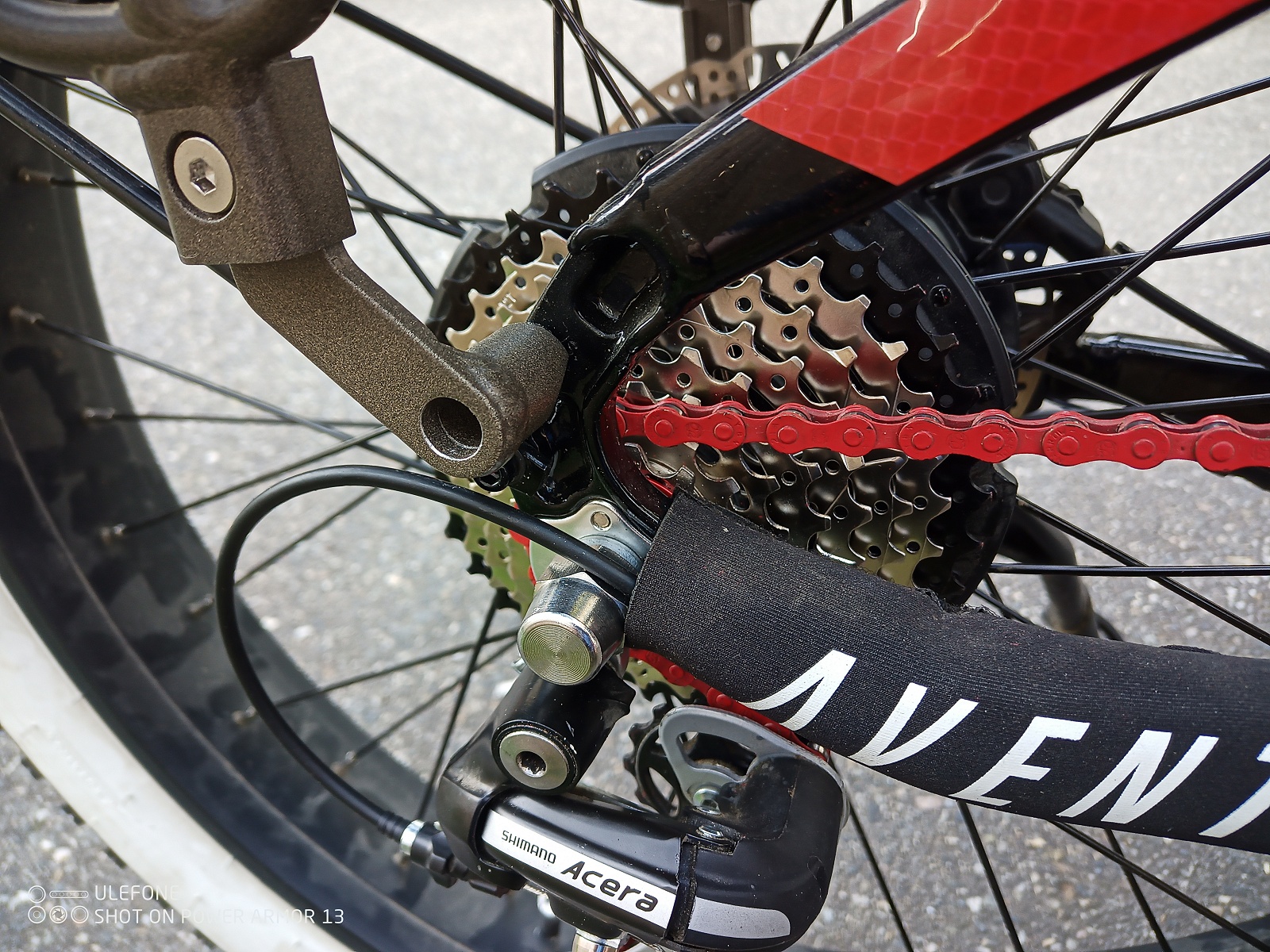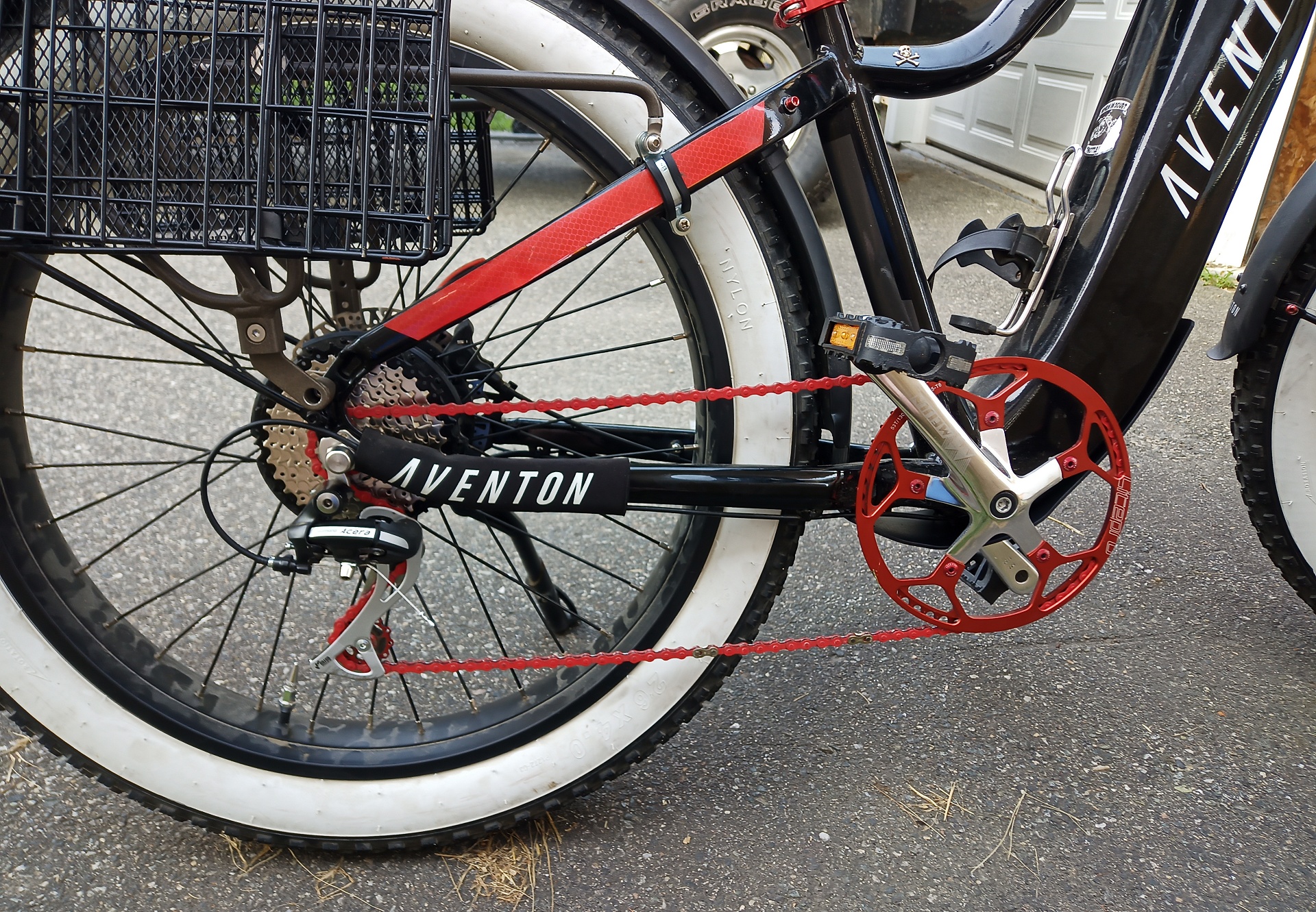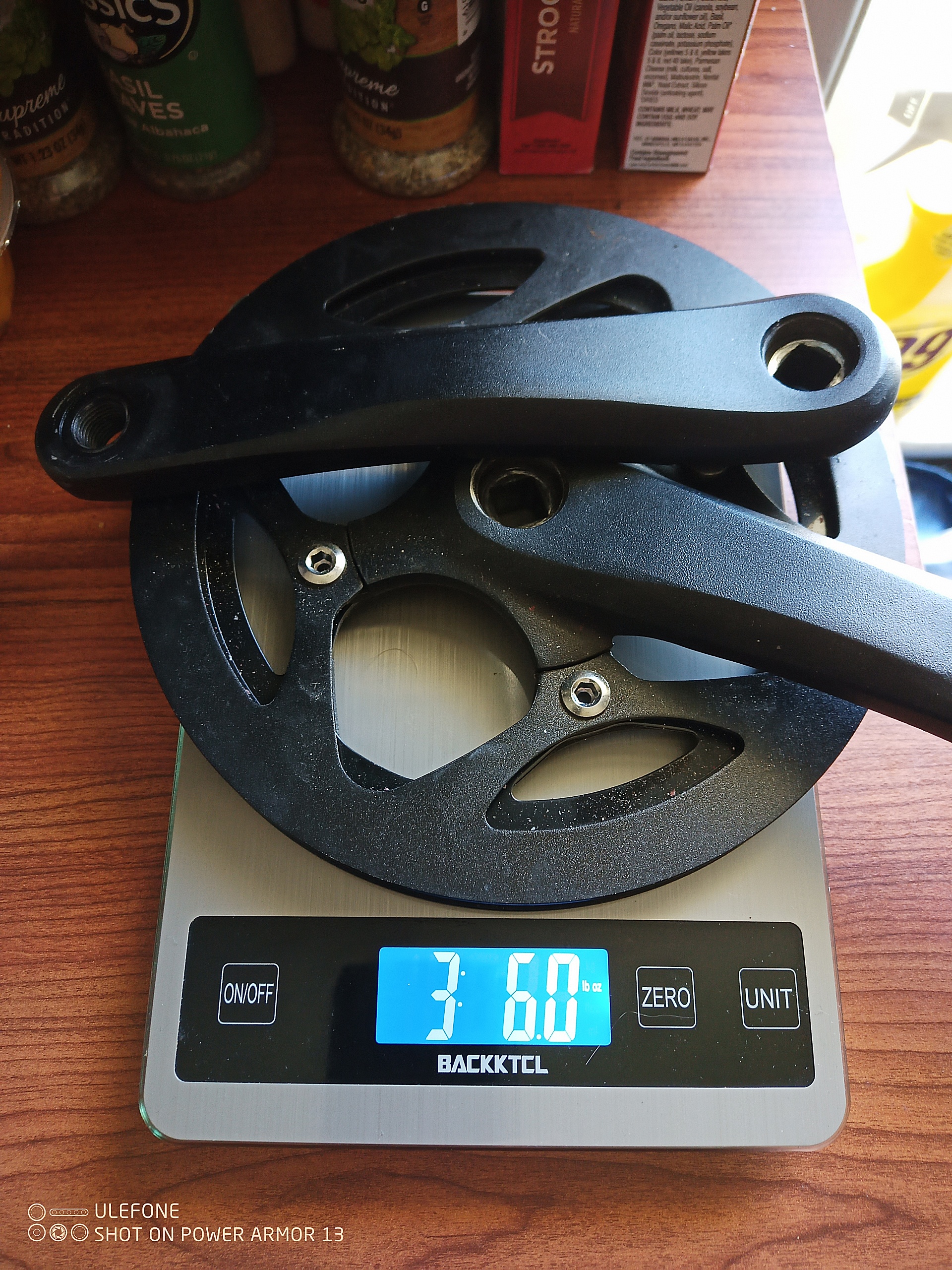Jason Knight
Well-Known Member
- Region
- USA
- City
- Keene, NH
When I got my Aventure one of the first things I noticed was the highest gear was weaksauce, and the lowest felt way WAY too low for me. The proverbial feet going like crazy to give my ass a ride.
So I put the largest cheap chainring I could find that fit around the chainstays, a great big old 53 tooth.
It confirmed a suspicion, and the past few months has proven me wrong on another.
The confirmed suspicion is that the highest gear ratio was indeed too weak. 46:12 on a 750 watt motor came up short which is why my feet were going like crazy at the top speed instead of a more comfortable rate. 53:12 was better, but it felt like there was still a hair more wiggle room.
Where I was wrong was on the low end. And I discovered this the most painful way -- accidentally running the battery out because I got lost on a path I don't normally take. Unpowered -- something I really hadn't done with it to that point, 53:32 is not conducive to an enjoyable ride on a 70 pound bike with the drag of the motor on it.
So I grabbed a cheap 11:36 cassette.

Which took a bit of finagling. Somehow the derailleur got out of whack -- one of many bike technologies I have trust issues with -- but held off on straightening out until the new cogset arrived. Because it's a tech I generally avoided and only ever had headaches with as a kid, and my being 20+ years out of date on bike tech, I tried just generically playing with the limits and adjustments, and very quickly made things worse.
Giant shout out to ParkTools for their instructional videos. Normally I can't learn from videos, but theirs was concise and "lacking in ego" enough to actually figure it out. Their "start with the low limit" approach worked like a charm.
The biggest hurdle was that the Acera is only really rated up to 34 tooth cogs, but the extra diameter was easy enough to get working by simply inserting the B screw the whole way. I have a couple derailleur hanger extensions in my parts bin, but I didn't want to resort to that if I didn't have to as that too seems a bit... sketchy... Just more possible points of failure. I also think my swapping the large 13 tooth plastic cogs on the derailleur for 11 tooth aluminum ones gave enough extra spacing for the larger cog.
I didn't up the chain length yet, as I wanted to test it more before I started playing with other factors. Easy enough later on since I've got those two master links in there and a bin-full more. I have this horrible habit of doing everything in bulk.

Wow, I really need to clean my rims. Pic taken straight after the test ride.
Pic taken straight after the test ride.
You can also see how I also swapped out the cranks for aluminum 170mm. Their website claims it comes with 170's... bullcookies. But that's like the "forged' cranks mine came with I swear are cast pig iron by weight alone. Much less the flash lines and casting sand texture.
I ran it up to top speed -- a nice clean 35mph -- and I still wasn't really struggling, but at least it still felt like there was tension on the cranks meaning I was going more muscle than motor. Which honestly is to me what an e-bike should be, even in the highest assist. It's called assist after all.
I also test rode it a quarter mile power off, and 53:36 is way better than 53:32. I could do that for miles if I had to. Which is good since I'm thinking on building a camper trailer and going a wee bit further out into the world.
I also took the time since I had the bike flipped over to put one of the aftermarket skid plates on it.
Which went on easy. Really well designed and thought out, even if the zip ties holding the rear are a bit sketchy when the bolt for the rear fender could have done double-duty just as the controller bolt-down does at the front. It's nice to cover up all those exposed wires on the bottom of the frame, which is IMHO one of the weakest points in the Aventure's design.
Overall it pedals smoother than it ever has -- that's probably just dialing in the limits and index -- and so far at least the gear range feels more natural and fits my riding style better. And since the second highest gear is 32T, in PAS 3 I can do the nice leisurely 18-20mph I had gotten into the habit of when trying to go longer distances.
So I put the largest cheap chainring I could find that fit around the chainstays, a great big old 53 tooth.
It confirmed a suspicion, and the past few months has proven me wrong on another.
The confirmed suspicion is that the highest gear ratio was indeed too weak. 46:12 on a 750 watt motor came up short which is why my feet were going like crazy at the top speed instead of a more comfortable rate. 53:12 was better, but it felt like there was still a hair more wiggle room.
Where I was wrong was on the low end. And I discovered this the most painful way -- accidentally running the battery out because I got lost on a path I don't normally take. Unpowered -- something I really hadn't done with it to that point, 53:32 is not conducive to an enjoyable ride on a 70 pound bike with the drag of the motor on it.
So I grabbed a cheap 11:36 cassette.

Which took a bit of finagling. Somehow the derailleur got out of whack -- one of many bike technologies I have trust issues with -- but held off on straightening out until the new cogset arrived. Because it's a tech I generally avoided and only ever had headaches with as a kid, and my being 20+ years out of date on bike tech, I tried just generically playing with the limits and adjustments, and very quickly made things worse.
Giant shout out to ParkTools for their instructional videos. Normally I can't learn from videos, but theirs was concise and "lacking in ego" enough to actually figure it out. Their "start with the low limit" approach worked like a charm.
The biggest hurdle was that the Acera is only really rated up to 34 tooth cogs, but the extra diameter was easy enough to get working by simply inserting the B screw the whole way. I have a couple derailleur hanger extensions in my parts bin, but I didn't want to resort to that if I didn't have to as that too seems a bit... sketchy... Just more possible points of failure. I also think my swapping the large 13 tooth plastic cogs on the derailleur for 11 tooth aluminum ones gave enough extra spacing for the larger cog.
I didn't up the chain length yet, as I wanted to test it more before I started playing with other factors. Easy enough later on since I've got those two master links in there and a bin-full more. I have this horrible habit of doing everything in bulk.

Wow, I really need to clean my rims.
You can also see how I also swapped out the cranks for aluminum 170mm. Their website claims it comes with 170's... bullcookies. But that's like the "forged' cranks mine came with I swear are cast pig iron by weight alone. Much less the flash lines and casting sand texture.
I ran it up to top speed -- a nice clean 35mph -- and I still wasn't really struggling, but at least it still felt like there was tension on the cranks meaning I was going more muscle than motor. Which honestly is to me what an e-bike should be, even in the highest assist. It's called assist after all.
I also test rode it a quarter mile power off, and 53:36 is way better than 53:32. I could do that for miles if I had to. Which is good since I'm thinking on building a camper trailer and going a wee bit further out into the world.
I also took the time since I had the bike flipped over to put one of the aftermarket skid plates on it.
Which went on easy. Really well designed and thought out, even if the zip ties holding the rear are a bit sketchy when the bolt for the rear fender could have done double-duty just as the controller bolt-down does at the front. It's nice to cover up all those exposed wires on the bottom of the frame, which is IMHO one of the weakest points in the Aventure's design.
Overall it pedals smoother than it ever has -- that's probably just dialing in the limits and index -- and so far at least the gear range feels more natural and fits my riding style better. And since the second highest gear is 32T, in PAS 3 I can do the nice leisurely 18-20mph I had gotten into the habit of when trying to go longer distances.
Last edited:
